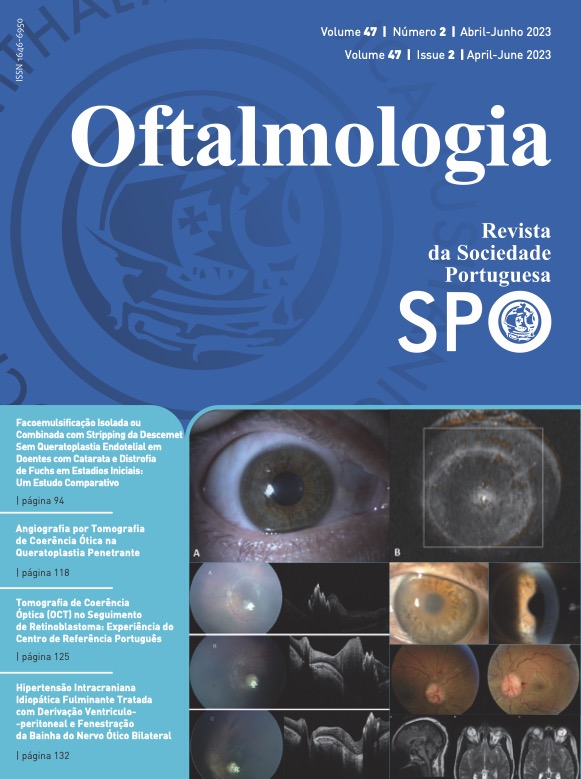Long-term Biomechanical Properties and Intraocular Pressure in Patients with Keratoconus After Penetrating Keratoplasty and Deep Anterior Lamellar Keratoplasty
DOI:
https://doi.org/10.48560/rspo.25903Keywords:
Biomechanical Phenomena, Cornea/physiology, Intraocular Pressure, Keratoconus, Keratoplasty, PenetratingAbstract
INTRODUCTION: Our aim was to compare long-term biomechanical properties and in- traocular pressure between eyes treated with penetrating keratoplasty (PKP) and deep anterior lamellar keratoplasty (DALK) in patients with keratoconus and healthy patients.
METHODS: Retrospective observational case-control study with corneal biomechanical evaluation by ultra-high-speed Scheimpflug imaging during noncontact tonometry (Corvis ST, OCULUS®). The intraocular pressure (IOP) was assessed with: Goldmann applanation tonometer; noncontact tonometer and biomechanically corrected by the Corvis ST and Pentacam corrected system (Ehlers, Shah, Dresden, and Spoerl correction).
RESULTS: The study included 104 eyes: 18 PKP-treated eyes, 34 DALK-treated eyes, and 52 healthy eyes. The average age at biomechanical assessment was similar between treated and healthy eyes (p=0.980). The mean follow-up time was similar between PKP- and DALK-treated eyes (p=0.273). PKP- and DALK-treated eyes showed significantly softer behaviour in 1st (19/28 and 21/28, respectively) and 2nd (8/11 and 9/11, respectively) generation biomechanical corneal pa-rameters compared to the control group. There was no difference in 1st and 2nd generation biome- chanical corneal parameters between PKP and DALK-treated eyes and between “big bubble” and “manual dissection” DALK techniques. When analysed postoperative IOP measured by different methods, mean values were similar between PKP- and DALK-treated eyes.
CONCLUSION: Neither of the two keratoplasty techniques fully restored corneal biome- chanics to those of healthy corneas. When comparing directly PKP and DALK-treated eyes, there were no significant differences in biomechanical behaviour. Mean postoperative IOPs measured by different methods were similar between PKP and DALK-treated eyes.
Downloads
References
Keratoconus [Internet]. NORD (National Organization for Rare Disorders). [cited 2021 Jun 7]. Available from: https://rarediseases.org/rare-diseases/keratoconus/
Rabinowitz YS. Keratoconus. Surv Ophthalmol. 1998 Feb;42(4):297–319.
Parker JS, van Dijk K, Melles GRJ. Treatment options for advanced keratoconus: A review. Surv Ophthalmol. 2015 Oct;60(5):459–80.
Arnalich-Montiel F, Alió del Barrio JL, Alió JL. Corneal surgery in keratoconus: which type, which technique, which outcomes? Eye and Vision. 2016 Jan 18;3(1):2.
Reinhart WJ, Musch DC, Jacobs DS, Lee WB, Kaufman SC, Shtein RM. Deep anterior lamellar keratoplasty as an alternative to penetrating keratoplasty a report by the american academy of ophthalmology. Ophthalmology. 2011 Jan;118(1):209–18.
Esporcatte LPG, Salomão MQ, Lopes BT, Vinciguerra P, Vinciguerra R, Roberts C, et al. Biomechanical diagnostics of the cornea. Eye and Vision. 2020 Feb 5;7(1):9.
Schulze-Bonsel K, Feltgen N, Burau H, Hansen L, Bach M. Visual Acuities “Hand Motion” and “Counting Fingers” Can Be Quantified with the Freiburg Visual Acuity Test. Invest Ophthalmol Vis Sci. 2006 Mar 1;47(3):1236–40.
Baptista PM, Marta AA, Marques JH, Abreu AC, Monteiro S, Menéres P, et al. The Role of Corneal Biomechanics in the Assessment of Ectasia Susceptibility Before Laser Vision Correction. Clin Ophthalmol. 2021;15:745–58.
Belin MW, Duncan JK. Keratoconus: The ABCD Grading System. Klin Monbl Augenheilkd. 2016 Jun;233(6):701–7.
Brookes NH, Loh I-P, Clover GM, Poole CA, Sherwin T. Involvement of corneal nerves in the progression of keratoconus. Exp Eye Res. 2003 Oct;77(4):515–24.
Meyer JJ, McGhee CNJ. Incidence, severity and outcomes of traumatic wound dehiscence following penetrating and deep anterior lamellar keratoplasty. Br J Ophthalmol. 2016 Oct;100(10):1412–5.
Hindman HB, McCally RL, Kim A, D’Anna SE, Eberhart CG, Jun AS. Evaluation of the effects of circular Descemet’s membrane incision on the biomechanical, topographic and optical properties of rabbit corneas. Clin Exp Ophthalmol. 2011 Oct;39(7):691–9.
John T, Taylor DA, Shimmyo M, Siskowski BE. Corneal hysteresis following descemetorhexis with endokeratoplasty: early results. Ann Ophthalmol (Skokie). 2007;39(1):9–14.
Hosny M, Hassaballa MAM, Shalaby A. Changes in corneal biomechanics following different keratoplasty techniques. Clin Ophthalmol. 2011;5:767–70.
Ma J, Wang Y, Wei P, Jhanji V. Biomechanics and structure of the cornea: implications and association with corneal disorders. Surv Ophthalmol. 2018 Dec;63(6):851–61.
Ziaei M, Vellara HR, Gokul A, Ali NQ, McGhee CNJ, Patel DV. Comparison of corneal biomechanical properties following penetrating keratoplasty and deep anterior lamellar keratoplasty for keratoconus. Clin Exp Ophthalmol. 2020 Mar;48(2):174–82.
Jiang M-S, Zhu J-Y, Li X, Zhang N-N, Zhang X-D. Corneal Biomechanical Properties After Penetrating Keratoplasty or Deep Anterior Lamellar Keratoplasty Using the Ocular Response Analyzer: A Meta-Analysis. Cornea. 2017 Mar;36(3):310–6.
Baradaran-Rafii A, Eslani M, Sadoughi M-M, Esfandiari H, Karimian F. Anwar versus Melles deep anterior lamellar keratoplasty for keratoconus: a prospective randomized clinical trial. Ophthalmology. 2013 Feb;120(2):252–9.
Akdemir MO, Acar BT, Acar S. Biomechanics in DALK: Big bubble vs manual lamellar dissection. Arq Bras Oftalmol. 2020 Apr;83(2):87–91.
Nawaz S, Sofi IA, Maharana PK, Shaveta S. Comparison of biomechanical properties between post penetrating keratoplasty and deep anterior lamellar keratoplasty in keratoconus patients using ocular response analyser. International Journal of Medical Research and Review. 2015 Oct 31;3(9):939–46.
Downloads
Published
How to Cite
Issue
Section
License
Copyright (c) 2023 Revista Sociedade Portuguesa de Oftalmologia

This work is licensed under a Creative Commons Attribution-NonCommercial 4.0 International License.
Do not forget to download the Authorship responsibility statement/Authorization for Publication and Conflict of Interest.
The article can only be submitted with these two documents.
To obtain the Authorship responsibility statement/Authorization for Publication file, click here.
To obtain the Conflict of Interest file (ICMJE template), click here





